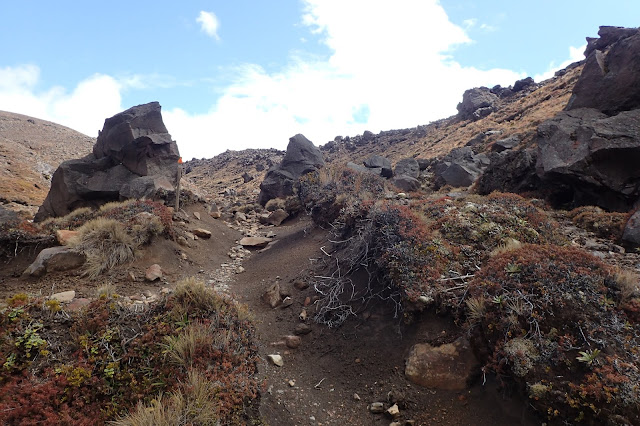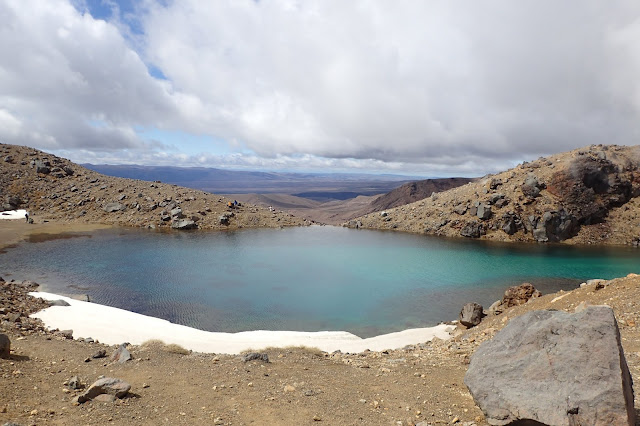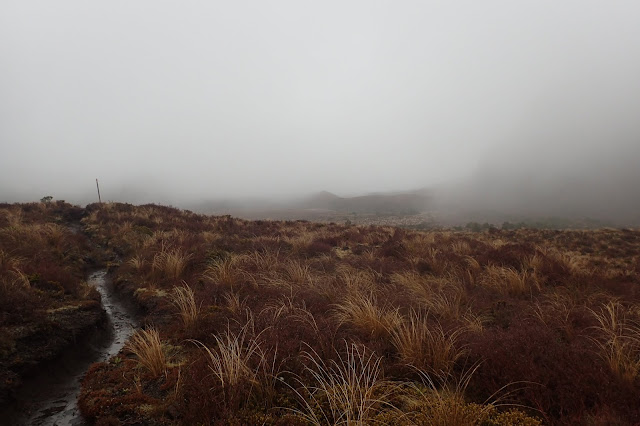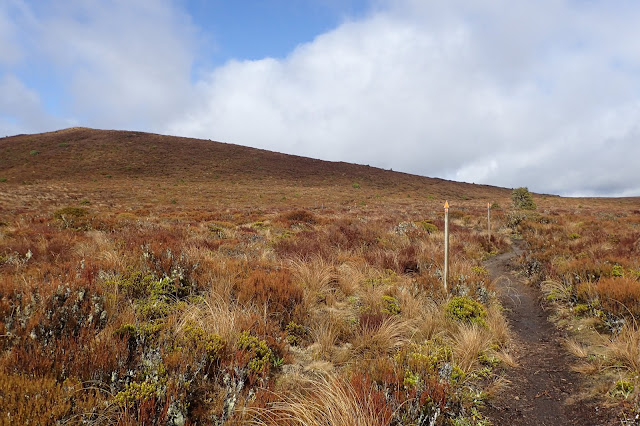The dull grey clouds were hanging low in the sky when I set off from the Whakapapa Village carpark at 11:30am. Somewhat embarrassingly, I was already breathing heavily when I got to the start of the track.
Luckily for me, the track is top notch - even, well-graded and well maintained. The track meanders through the tussock and scrub, on a clear day the open landscape would provide great views of the mountains, but even in the gloom it was still a sight to behold.
It was a fairly short 45 minutes to the Taranaki Falls junction.
The base of the falls is a quick (but steep) detour off the Tama Lakes track, and well worth a look. The 20m falls plunge dramatically over the edge of an old lava flow.
Once back at the junction, the well-marked track continues through the windswept landscape, slowly climbing toward Tama Saddle.
As Tama saddle is neared, the landscape gradually becomes more dramatic as the flanks of Ngauruhoe to the north-east and Ruapehu to the south come into view. The mountains themselves remained illusive, mostly hiding behind a thick veil of cloud.
7.2km/2hr 10 min from the start, I reached the signposted junction for Tama Lakes, a pair of old craters now filled with water. I only went as far as the Lower Tama viewpoint, which was a great place to sit and eat for a few minutes.
From the junction, the track across Tama Saddle becomes more rugged, having left the world of touristy day walks behind. After the saddle, the track begins to descend slowly into the broad and open Waihohonu Valley.
 |
| Tama Saddle |
 |
| Waihohonu Valley from Tama Saddle |
The views over the Waihohonu Valley are initially inspiring, and then a bit frustrating when I realised how far away the hut still was.
Eventually, the track meets the Waihohonu Stream. From then on, the track is never far from the stream as Waihohonu Hut draws closer. I was slowing down at this point, not used to covering this kind of distance in a day. It was also about now that the rain, which had been coming and going all day, now began to properly set in.
The volcanic landscape is endlessly fascinating, which provides an excellent distraction the growing aches, suspicions of blister formation, and persistent rain.
16.8km from the start, and not far from the hut, a signposted junction gives direction to the original Waihohonu Hut, built in 1903.
Shortly before reaching the current hut (it's 3rd incarnation) becomes visible. The swanky hut was a welcome sight after a long, and now quite damp, day.
I reached the hut after 5hr 50mins (17.7km).
 |
| "Welcome to the Chateau Waihohonu" - Sam, DOC Ranger |
Day 1 GPS data:
Total distance: 17.7km. Total time: 5 hr, 47 min. Overall average speed: 3.1km/h.
Map:
Day 2 - Waihohonu Hut to Oturere Hut
There was plenty of cloud still hanging around as I hobbled around the hut, getting breakfast and packing up my gear. Thankfully the forecast was looking alright, and the tramp to Oturere much shorter than the previous day. With the weather currently holding out, and my pack ready to go, I decided to head out early, leaving the hut at around 8:15am.
From the hut, the track almost immediately enters beech forest reminiscent of parts of the Tararuas and drops down to a footbridge over the Waihohonu stream, then passing the camping site before beginning to climb up a ridge.
 |
| Section of track could easily be anywhere in the Tararuas |
The track leaves the forest near the top of the ridge, then re-enters it when descending down the other side. At the bottom, a bridge crosses another significant stream, then begins to climb again.
Once the ascent is over and done with, the track follows a fairly direct path to Oturere.
I stopped briefly at a convenient sitting boulder at the top of the second ridge before heading on. The rest of the track is pretty easy going (as far as volcanoes go), undulating around the 1200m contour, crossing open gravel slopes with the odd rocky patch.
The track itself is inherently indistinct, but regular and abundant marker poles make it easy to follow. To the east, the desert road and nearby electricity pylons are visible, and Ngauruhoe looms to the west. With no need to hurry (and joints still aching from the day before) I dawdled through most of this day.
Not far from the hut, a jagged and rocky land form (an old lava flow) makes a stark contrast to the relatively smooth slopes the track has crossed until the point. The track climbs steeply onto this old lava flow, and the hut is reached just under 1km later.
The welcome sight of Oturere hut appears relatively suddenly, nestled in the tussock at the end of the Oturere Valley lava flow. I reached the hut bang on 12pm.
The hut is cosy (read: small), with plenty of bunks but limited communal space. Like Waihohonu, the hut has solar powered lighting and a wood fire. Lucky for me, I was sharing the hut a good bunch of people, and a different friendly DOC ranger by the name of Jamie.
As an added bonus, there's a pretty cool waterfall that can be seen from just north of the hut (but can't be seen from the hut or the track). A narrow trail can be followed to the top of the waterfall (and also apparently to the bottom, but the climb back up put me off trying that out).
Day 2 GPS data:
Total distance: 8.1 km. Total time: 3 hr, 44 min. Overall average speed: 2.16 km/h.
Map:
Day 3 - Oturere Hut to Mangatepopo Hut
After having plenty of time to rest up at Oturere, I felt quite refreshed as I departed. That, and the good forecast weather, had me in high spirits as I walked up the otherworldly Oturere Valley.
It's difficult to describe this place, because there isn't really anything to compare it to. Bizarre rock formations surround the track; lumpy, jagged boulders litter the ground; the landscape is barren and alien - the result of ancient lava flows. It's a surreal place, and the mostly pretty flat gradient makes it all the more easy to enjoy. It's a landscape that could just as easily look at home in Doctor Who or Star Trek as it would in Lord of the Rings.
The indistinct form of Tongariro awaits at the head of the valley. It's a steep, but thankfully short climb up from the valley to central crater. The clearing cloud afforded excellent views back across the Oturere valley and towards the mountains, giving me ample excuse to stop and catch my breath.
As I got closer to the top, the ant-like forms of walkers on the Tongariro Apline Crossing became visible.
All of sudden the track crests the top of the incline and arrives at one of the Emerald Lakes, and a completely different world to that of the Oturere valley - the fairly flat basin of the central crater surrounded by the snowy peaks of Tongariro. It feels cheesy to describe something as magical and breathtaking but I can't think of better words. In fact, I distinctly remember saying something along the lines of "woah" and "holy shit that's magical."
The track moves around the lake and meets the TAC in the snowy central crater. The circuit heads south toward Red Crater, with the crossing continuing north across central crater to Blue Lake and Ketetahi.
I decided to take a brief sojourn through the snow to blue lake.
It was an incredible place to be, and words and photos don't really do it justice, but suffice it to say that it was one of most spectacular and beautiful places I've ever been.
After returning to the junction, I ran into some fellow trampers from Oturere Hut and began the climb past the other Emerald Lakes up to Red Crater. It's quite a steep climb up loose scoria, although not as narrow as it looks from the bottom. There were also a great many TAC walkers coming down, so much patience and tourist-slalom skills were required.
Once again: absolutely beautiful and defies description.
The highest point of the track, Pt 1868, above red crater offers breathtaking views of the Tongariro Mountains and surrounding area.
By this time, it had been 3hr50/6.77km since Oturere Hut, but I was far too lost in the views to notice how long I'd been walking.
From red crater, the track descends steeply over rocky terrain down to South Crater-that-technically-isn't-a-crater, the near perfect cone of Ngauruhoe looms constantly.
After the last bit of up and down, South Crater is mercifully flat. The track then zigs and zags down to the Mangatepopo valley.
Near the top of the valley, the soda springs waterfall is worth checking out. From there it was a fairly straightforward walk to Mangatepopo hut. Although by this point I had begun to notice the aches and pains seeping back into my legs.
The track (much of it boardwalk), wends it's way between lava formations and tussock, alongside a small stream that would be aptly described as a babbling brook.
Mangatepopo hut can be seen long before it is reached, and lies a short distance off the main track.
It took me a lot longer than the DOCtime of 5 hours to get to Mangatepopo - almost 7hr all up, but to be honest it still feels like I didn't spend enough time just soaking it all in.
Needless to say I very much enjoyed a lie-down and hot meal before getting a good nights sleep.
Mangatepopo was a comfortable hut with two bunkrooms off opposite sides of the communal cooking/dining area and a bit more space than Oturere. Like the others, the hut has solar lighting and gas cooking, but gas heating rather than a woodfire. The tussocky Mangatepopo valley and Ngauruhoe are visible from the large front decking.
Day 3 GPS data:
Total distance: 13.8 km. Total time: 6 hr, 47 min. Overall average speed: 2.03 km/h.
Map:
Day 4 - Mangatepopo Hut to Whakapapa Village
Low cloud and misty rain greeted me when I woke up. Someone had fired up the gas heater so the hut was nice and warm though.
Layered up warm and dry, I headed out on what would hopefully be a short tramp back to Whakapapa Village. I had read that the track was in bad shape, heavily eroded and such, but it's really not as bad as all that. Sure, it's not up to the same Great Walk standard as the rest of the circuit, but it's otherwise just a fairly standard tramping track.
The track is indeed quite eroded and rutted in places, particularly badly in a few places, which can be annoying - but nothing to ruin your day.
The track heads roughly south over the flanks of Pukekaikiore and crosses a number of small but deep stream gullies (almost all of which were completely dry). Getting in and out of the gullies was often a bit of a scramble. At one point, the track briefly follows a tiny creek down one of these weird little gullies, which was pretty neat. Closer to Whakapapa, the track improves a bit, and crosses a few streams, most with the aid of bridges and stairs.
Not far from Whakapapa, beech forest starts popping up, and the track crosses a bridge over the Wairere stream and intersects the lower Taranaki Falls track. From there, it was about 20 minutes back to Whakapapa Village.
Although I was walking slowly at times, it was pretty much non-stop 3 hours back to Whakapapa and a comfy night at the Chateau.
Day 4 GPS data
Total distance: 9.31 km. Total time: 3 hr, 3 min. Overall average speed: 3.04 km/h.
Map:
Without doubt, this was the single most spectacular tramp I've ever done. Not to denigrate the humble Tararuas, but there's something so unique and incomparable about crossing through and over an active volcanic landscape. Equal parts dramatic, awe-inspiring, rugged and beautiful, there's very good reasons why the Tongariro National Park is as popular as it is. A Great Walk indeed.
Total Distance: 48.9km.
Map:
References:
DOC - Tongariro Northern Circuit
Wilderness Magazine


























































































































No comments:
Post a Comment